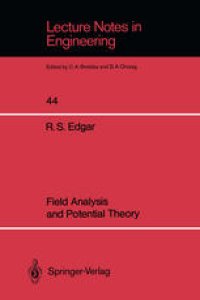
Ebook: Field Analysis and Potential Theory
Author: Robert Steel Edgar (auth.)
- Tags: Elementary Particles Quantum Field Theory, Appl.Mathematics/Computational Methods of Engineering, Engineering general, Communications Engineering Networks
- Series: Lecture Notes in Engineering 44
- Year: 1989
- Publisher: Springer-Verlag Berlin Heidelberg
- Edition: 1
- Language: English
- pdf
"Electromagnetic theory is a peculiar subject. The peculiarity resides not so much in the stratification - superposed layers of electrostatics. magnetostatics. steady currents and time-varying fields - as in the failure that has attended all attempts to weld these layers into a logical whole. The lowest layer. electrostatics. defines certain concepts. such as E. D, ~, in a way that is generally satisfactory only for the static case. Yet the attempt is made to force these specialised definitions into the higher strata, with ad hoc modifications when necessary. The student, in looking through his text books on electromagnetics, can find general definitions only with difficulty. if at all; and even the most advanced treatises fail to present a rigorously logical development of the subject". 1 So wrote Moon and Spencer some 30 years ago; and their criticism continues to be pertinent today. 2 More recently. a senior physicist of the National Bureau of Standards has expressed his concern in similar terms: "A logically consistent set of definitions of the electromagnetic field quantities is extremely difficult to find in the literature. Most text books either evade the problem or present definitions that are applicable only to special cases".
The text of this book comprises a thorough and detailed exposition of the mathematical theory of potential and its application to classical electromagnetic field theory. In as much as a prior knowledge of little more than vector addition and multiplication is assumed on the part of the reader, selected portions are suitable as an undergraduate text in vector analysis; at the same time the level of development is such that it may serve as a text for advanced graduate students, teachers and all professionally mature researchers in the areas of communication electromagnetics, plasma physics, electromagnetic compatability, magnetics and geomagnetism. And for students, teachers and all professionals concerned with the foundations of classical electromagnetic theory as embodied in the Maxwell-Lorentz equations, the work offers a novel approach and logical development free from many of the difficulties inherent in the conventional treatment. Over 400 exercises of varying degrees of difficulty are spread throughout the text.
The text of this book comprises a thorough and detailed exposition of the mathematical theory of potential and its application to classical electromagnetic field theory. In as much as a prior knowledge of little more than vector addition and multiplication is assumed on the part of the reader, selected portions are suitable as an undergraduate text in vector analysis; at the same time the level of development is such that it may serve as a text for advanced graduate students, teachers and all professionally mature researchers in the areas of communication electromagnetics, plasma physics, electromagnetic compatability, magnetics and geomagnetism. And for students, teachers and all professionals concerned with the foundations of classical electromagnetic theory as embodied in the Maxwell-Lorentz equations, the work offers a novel approach and logical development free from many of the difficulties inherent in the conventional treatment. Over 400 exercises of varying degrees of difficulty are spread throughout the text.
Content:
Front Matter....Pages i-xii
The Differential and Integral Calculus of Vectors....Pages 1-108
Curvilinear Coordinate Systems....Pages 109-167
Green’s Theorem and Allied Topics....Pages 169-216
Unretarded Potential Theory....Pages 217-394
Retarded Potential Theory....Pages 395-573
Helmholtz’s Formula and Allied Topics....Pages 575-606
Exponential Potential Theory....Pages 607-664
Back Matter....Pages 665-700
The text of this book comprises a thorough and detailed exposition of the mathematical theory of potential and its application to classical electromagnetic field theory. In as much as a prior knowledge of little more than vector addition and multiplication is assumed on the part of the reader, selected portions are suitable as an undergraduate text in vector analysis; at the same time the level of development is such that it may serve as a text for advanced graduate students, teachers and all professionally mature researchers in the areas of communication electromagnetics, plasma physics, electromagnetic compatability, magnetics and geomagnetism. And for students, teachers and all professionals concerned with the foundations of classical electromagnetic theory as embodied in the Maxwell-Lorentz equations, the work offers a novel approach and logical development free from many of the difficulties inherent in the conventional treatment. Over 400 exercises of varying degrees of difficulty are spread throughout the text.
Content:
Front Matter....Pages i-xii
The Differential and Integral Calculus of Vectors....Pages 1-108
Curvilinear Coordinate Systems....Pages 109-167
Green’s Theorem and Allied Topics....Pages 169-216
Unretarded Potential Theory....Pages 217-394
Retarded Potential Theory....Pages 395-573
Helmholtz’s Formula and Allied Topics....Pages 575-606
Exponential Potential Theory....Pages 607-664
Back Matter....Pages 665-700
....